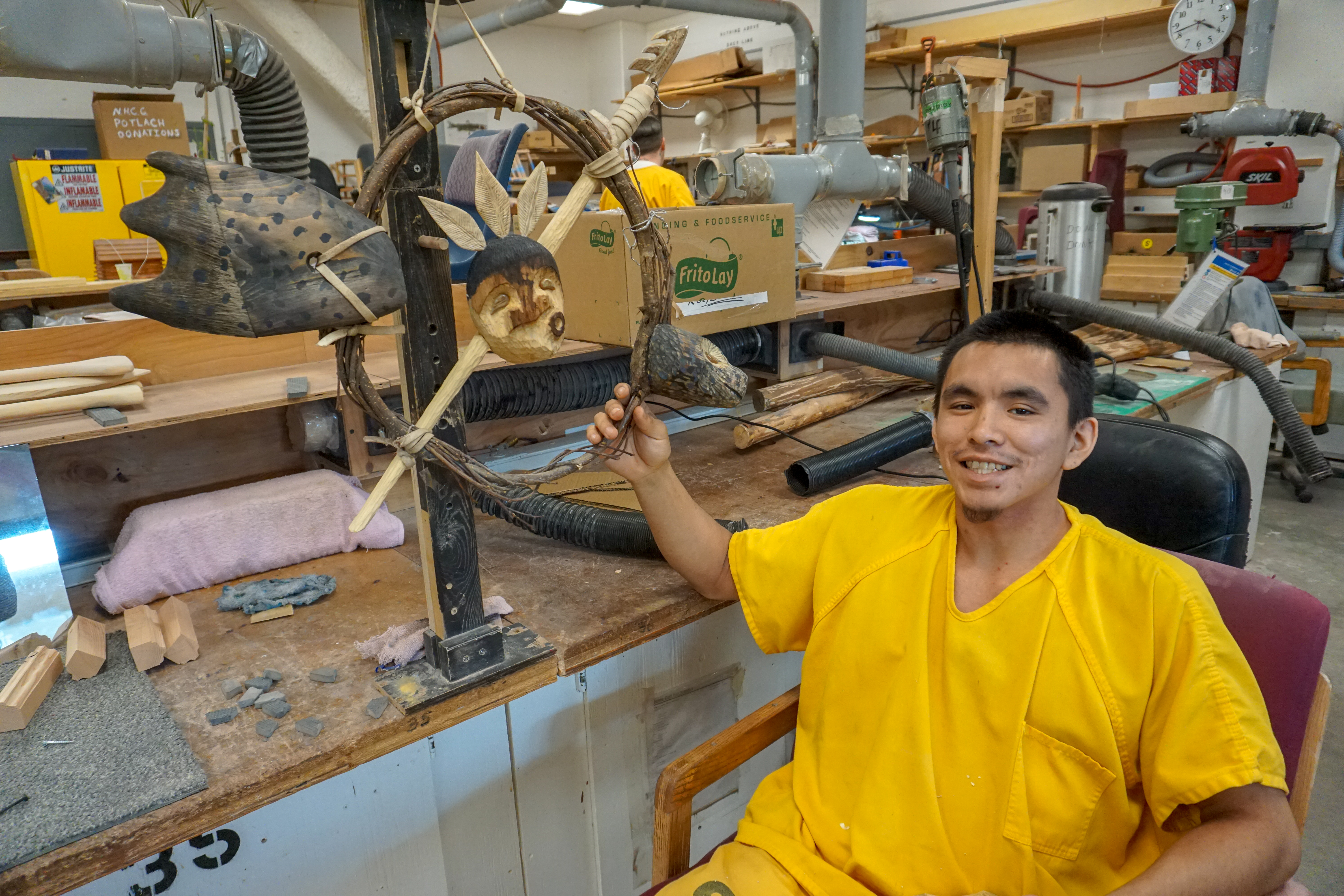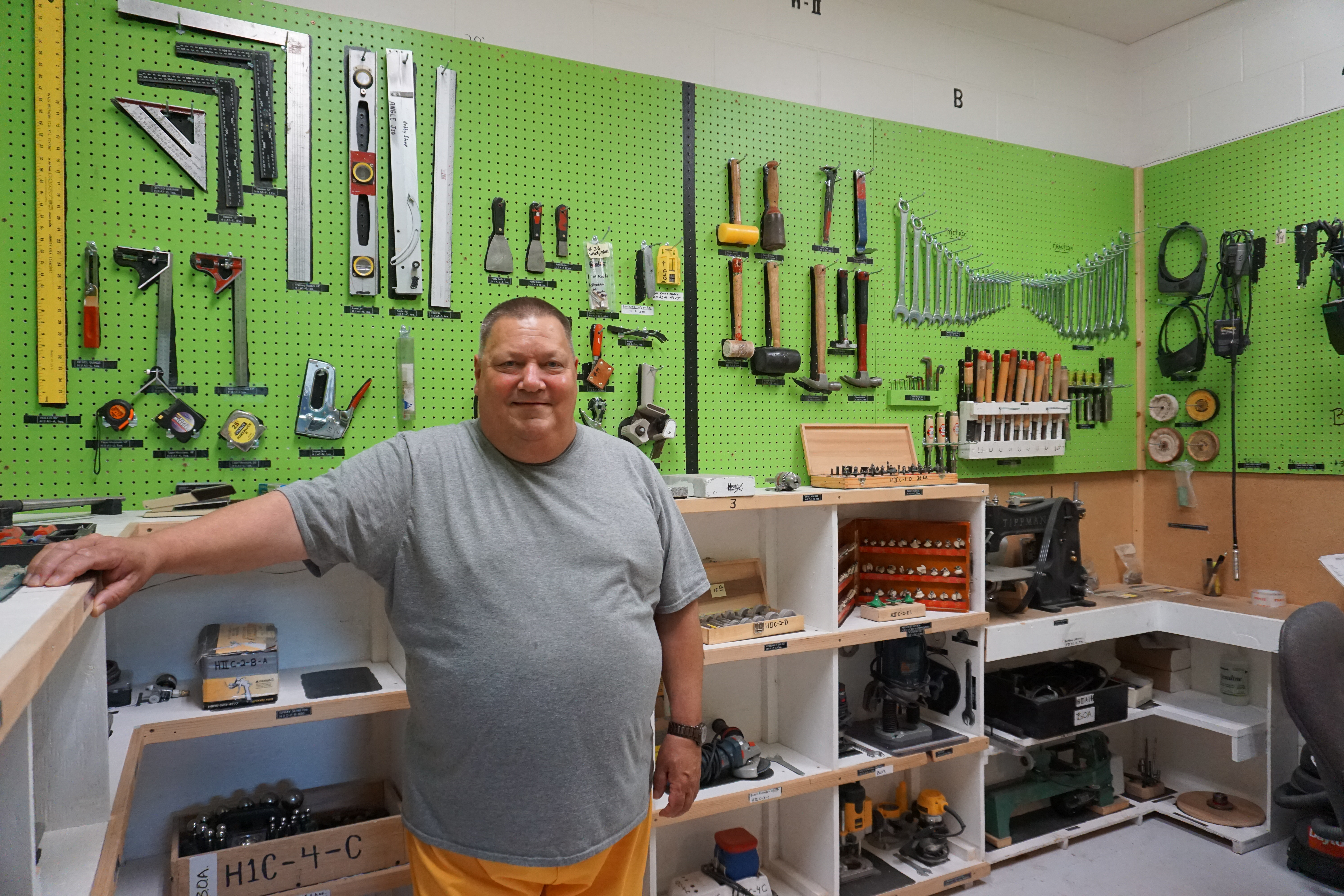
Spring Creek Correctional Center has a unique legal internal economy.
The inmates run a prison store that sells food, hygiene items and clothing.
Profits from the store stay inside the facility and are divided up between nine different funds, including one that provides equipment for the hobby shop.
Anthony Garcia sat at a long table facing the cement wall of the prison’s hobby shop, a rhythmic tapping filling the air.
He was using an air-powered tool to engrave a piece of silver with tiny forget-me-not flowers.
A small desk light shone on the intricate pattern.
A shelf above his workstation held books on handicrafts and Mayan art and supply catalogs.
“This is where I do all my thinking right here,” Garcia said. “This takes you away, too. Sometimes I’ll have my headphones on, have the music going, and just get lost.”
Garcia has been – and will be – in prison for a long time.
When he’s not in the hobby shop, he’s teaching classes on morals and ethics to other inmates, hoping they won’t end up in the same situation.
Garcia said being in the hobby shop helps him focus, and makes him some money.
He sells his bracelets and carvings then reinvests it back into his work, buying his own silver, copper, and wood.
“I just save my money, I’ll sell that stuff out,” he said pointing to a pile of packaged bracelets and other small items. “The money comes back in, and I’ll make another order. If I make $400, I’ll put $300 back in silver. It just keeps going, keeps going, keeps going.”
He said he spends the profits in the prison store. “I gotta eat. (I get a) box of chicken!”

But Garcia’s art isn’t as lucrative as it could be.
He first learned to carve 10 years ago at Lemon Creek Correctional Center in Juneau, where an expert taught him to make paddles.
He shows off a long piece of yellow cedar engraved with a beaver and a welcoming hand sign.
“I was getting $500 a paddle in Juneau and up here, I’m lucky if I can get $200,” he said.
There are a limited number of ways the inmates can sell their work, Spring Creek superintendent Bill Lapinskas said.
Some mail it to their families who sell it for them on the outside.
Others put it in a glass case by the visiting room and hope it will be purchased.
Lapinskas allows inmates to sell to each other, too, through the shop.

“If a guy wanted to buy his mom a nice bracelet for Mother’s Day, they can do that through the shop,” he said. “Again keeping some of the hard-earned money in-house and supporting their craft.”
But Lapinskas said the market both inside and outside the prison is too small.
Too many of the guys are making copper and silver bracelets.
“I want to get him what he should be getting for that,” he said, pointing up to Garcia’s elegant paddle. “I don’t think people should be getting a deal just because the market is saturated. Not for work like that. This isn’t Walmart.”
The problem is very common.
Wendy Jason with the Prison Arts Coalition said it’s hard for prison artists across the country to sell their work.
In some places it’s illegal, but rules vary by state and by institution.
According to Jason, who has been working with the coalition for eight years, the guys at Spring Creek actually have it better than most because they have the support of the institution’s staff.
“What they’re doing there is unique. It is pretty uncommon,” she said. “In most cases prisons, prison officials are not by any means that supportive of the arts.”
Jason said people frequently contact her looking for advice on how to sell their work or the work of a loved one.
She said some websites do market work for inmates, but the safest idea is for inmates to give it to people they trust and have them sell it for them.
She also recommends that they not discuss the transactions over phones or by letter because communication is often monitored, and inmates have been punished for selling their work.
Despite the risks, Jason said selling inmate art is valuable on many levels.
“They’re creating something inside (prison] that’s not just income generating, but it’s something meaningful to them,” she said of the art. “It’s a piece of them that they’re sharing with the world, and so they’re no longer completely disconnected and silenced. And it’s bringing in a little money for the family that they’re not able to be with.”
Lapinskas said he’s exploring options like setting up an Etsy shop or selling at fairs in Anchorage.
In the meantime, many of the craftsmen are creating works to donate to local fundraising auctions in addition to trying to sell on their own.
Because even if they can’t make money, they can still help others while they make art.
